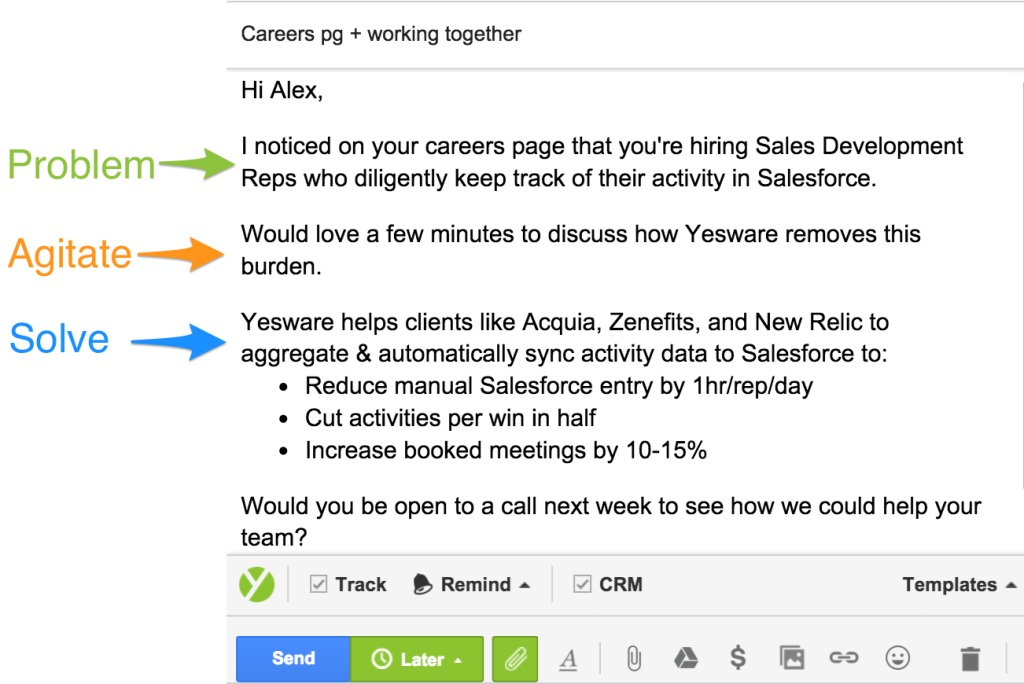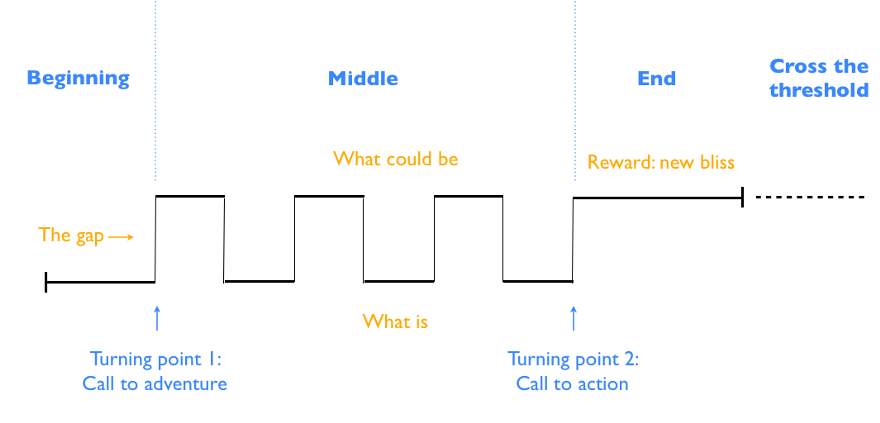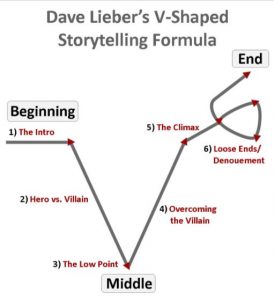Scrolling through social media marketing platforms, there are many patterns marketers can use to supercharge their branding, storytelling, and business as a whole. Many businesses and corporations use these strategies and formulas in social media posts, especially high-profile ones such as Apple, Airbnb, and Nike.
In order for these strategies to be effective, marketers must first understand the formulas that go into creating stories designed to sell a product/service or promote a message.
Here are seven of the most popular and effective structures used:
Contents
The Three-Act Approach
One of the most commonly used structures in social media posts, the three-act approach is straightforward and gets the point across.

To implement the three-act approach:
- Set up the scene and introduce the character. For example: “Lauren has always had a passion for helping children learn to read.”
- Present a conflict or rising action. To continue the previous example: “She loves seeing their faces light up with new knowledge but didn’t know how to continue that at home.”
- Finally, solve the problem. To finish: “That’s when she discovered ABC Mouse, a computer program designed to help children achieve literacy wherever and whenever.”
Before – After – Solution
This formula presents an issue that the average person is likely to experience, identifies a solution, then recommends a method to achieve the ideal outcome all in a social media post. It helps explain how a product or service acts as a bridge to achieve the desired scenario that is hoped for at the beginning.
- Describe a society or scenario with a typical issue. For example: “For busy Americans, sometimes grocery shopping is something that just cannot be fit into a schedule.”
- Give an ideal solution, such as, “Imagine being able to pay someone willing to go and do your grocery shopping for you.”
- Then, provide a reasonable way to achieve that solution. “With Instacart, you can designate someone to do your shopping for you and come home with a stocked kitchen.”
Problem – Agitate – Solve
Though this formula is similar to the Before-After-Solution (bridge) structure, this method involves the use of examples that shows why the problem is not ideal. Then, it gives the ultimate solution that is provided by a product or service.
- Present an issue. E.g. “Calling a taxi on a busy night can be a mood killer.”
- Emphasize the problem and explain why: “Having to track one down and pay a large sum of money just to get home is not always ideal.”
- Then give a solution to the problem: “That’s why Uber is available to quickly find rides for you at the cheapest rate possible.”
- If needed, insert a call-to-action. “Download the app today and start riding wherever you need with trusted drivers!”
Nancy Duarte’s Status Quo Secret
Nancy Duarte’s TED Talk “The Secret Structure of Great Talks,” which has been viewed over a million times, reveals this tactic that has been used by icons such as Steve Jobs and Martin Luther King. This method starts by acknowledging the status quo and providing a better situation for the future.

- What is the status quo? E.g. “In the world of social media, people everywhere enjoy filtering their pictures to enhance them, but sometimes it ruins the original effect.”
- What could the world be like if this was solved? “Imagine what Instagram and Facebook would look like if people naturally edited their pictures so we could experience the beauty or experience they saw.”
- Present a solution to achieve the second step. “With VSCO, users can use premade filters and adjust it to their liking to ensure that their pictures still feel natural and real.”
Dale Carnegie’s Formula
According to Dale Carnegie, developer of courses in self-improvement and salesmanship, opening social media posts with a personal anecdote is an effective way to grab an audience’s attention. Be sure to qualify how the story led to success.
- Describe the incident: “With my life revolving around digital communication, it was difficult to keep all of the conversations organized. I could never easily find the person I needed to be in contact with.”
- Explain the action you took to solve the problem: “I went on a hunt for a new app that would keep everything together, and that’s how I found Slack.”
- State how the new discovery benefitted you: “Now, I’m able to be in contact with anyone I need easily, and it shows other users when I am available and when I am not.
Dave Lieber’s V Formula
Keynote speaker and News Watchdog columnist, Dave Lieber, shares his successful storytelling formula in his TED Talk “The Power of Storytelling to Change the World.”
Similar to Dale Carnegie’s, Lieber believes in starting a story with an anecdote. What separates the two is that Lieber brings the story to the lowest point before giving the solution. This structure is V-shaped, where it starts fine, then reaches the bottom, but brings it back to the top.
- Introduce the character and make everything seem normal. For instance, “Daniel was always a gifted writer, making sure to get every thought onto paper.”
- Bring the story to its lowest point where the character thinks, “how am I going to get out of this one?” To continue, “When he lost his job, writing was his relief, but he could not find a way to share it.”
- Then, bring the story back up through a certain solution. “When David found Medium, he was able to share his ideas with a new community and found a job through it that contributed to his passions.”
The Superhero Approach
Tell the story of the hero of a group and how they got there. The hero is the one who stands out in the crowd and discovers new things.
- The challenge: a hero gets called with a series of challenges they are faced with. E.g. “The organization of the company was in shambles. Nobody knew who was working on what due to the lack of communication tools.”
- The mission: the hero finds out how to solve the problem and goes on to help everyone out. “Until you found Asana, there was no hope that people could reach the highest level of productivity. You introduced it to your boss and teammates, and their worlds were changed.”
- The impact: explain how the hero’s mission shaped the team and its work. “Now, everyone knows exactly what is expected of them and have a platform to share ideas and concerns.”


